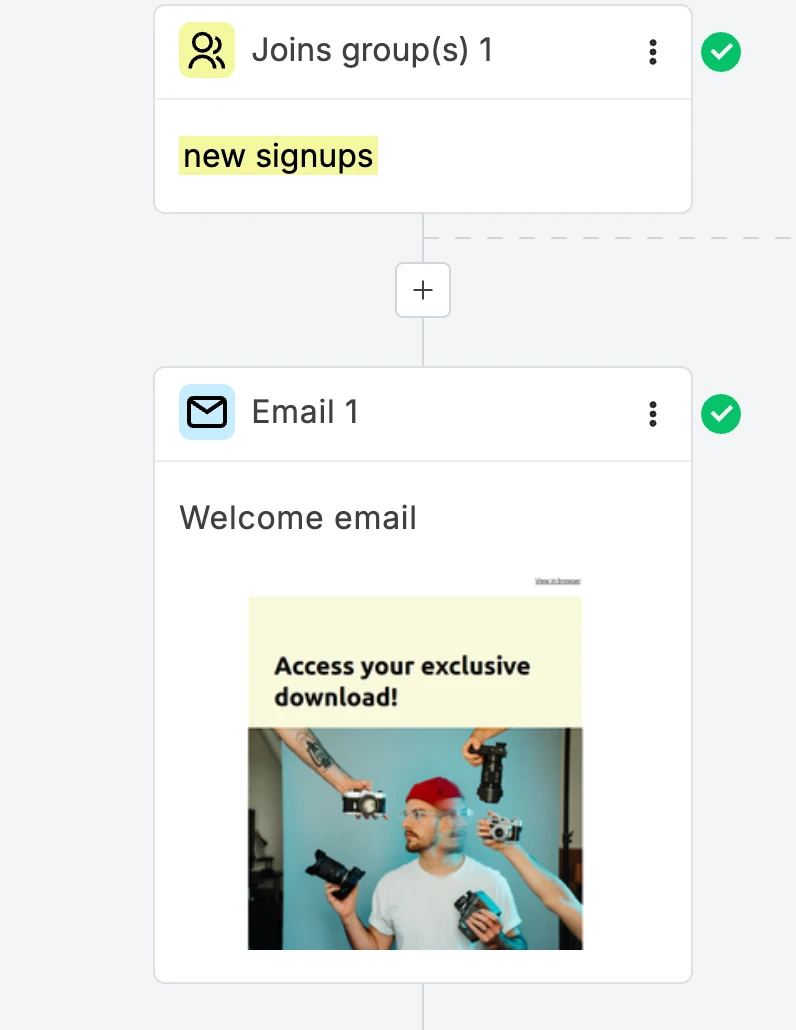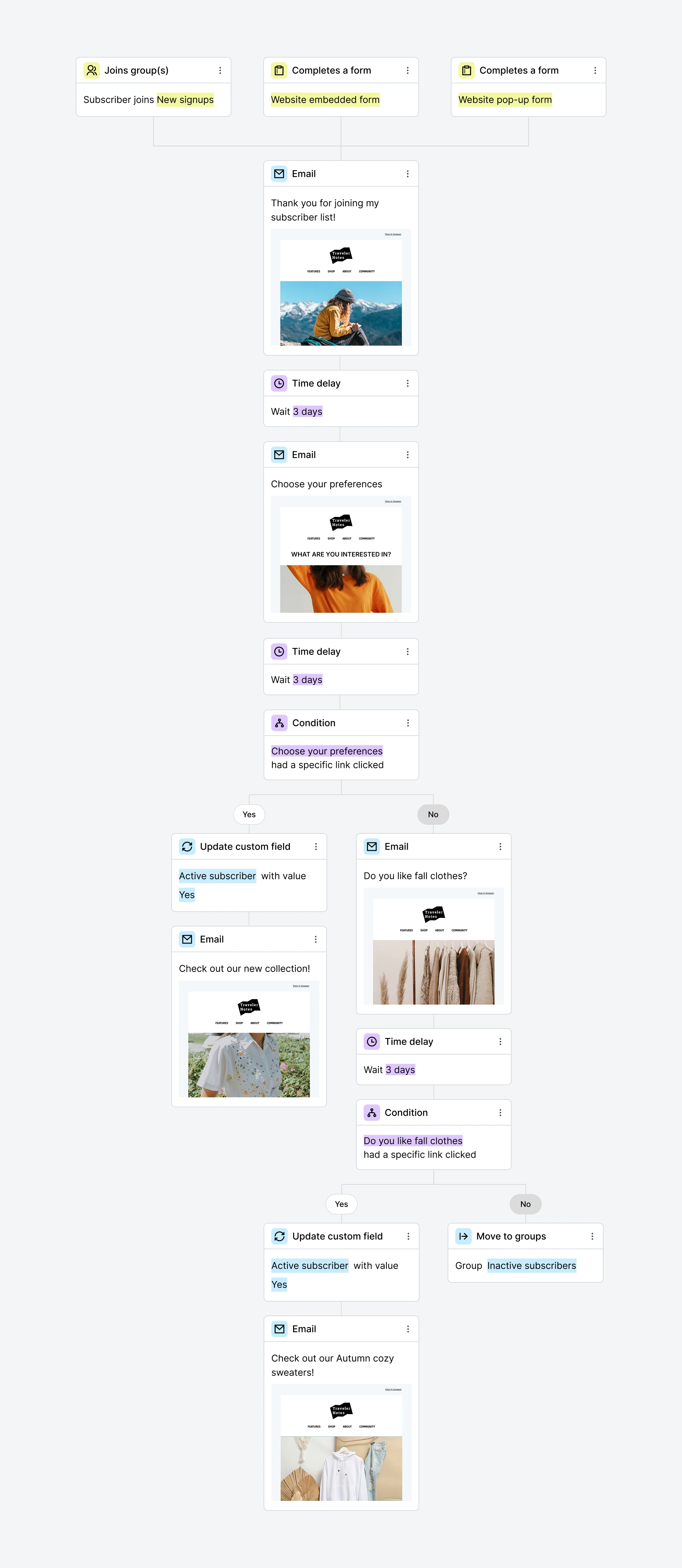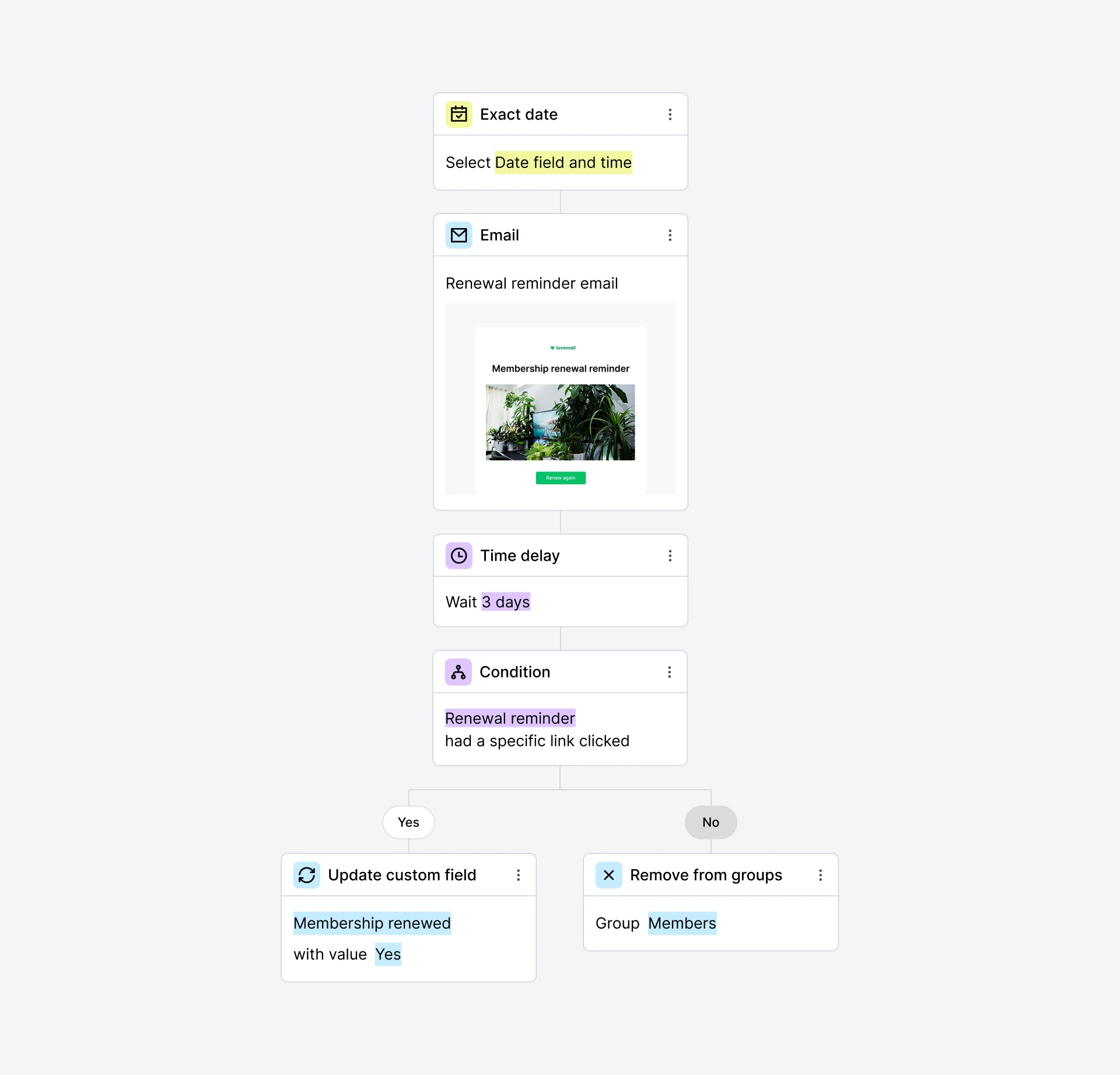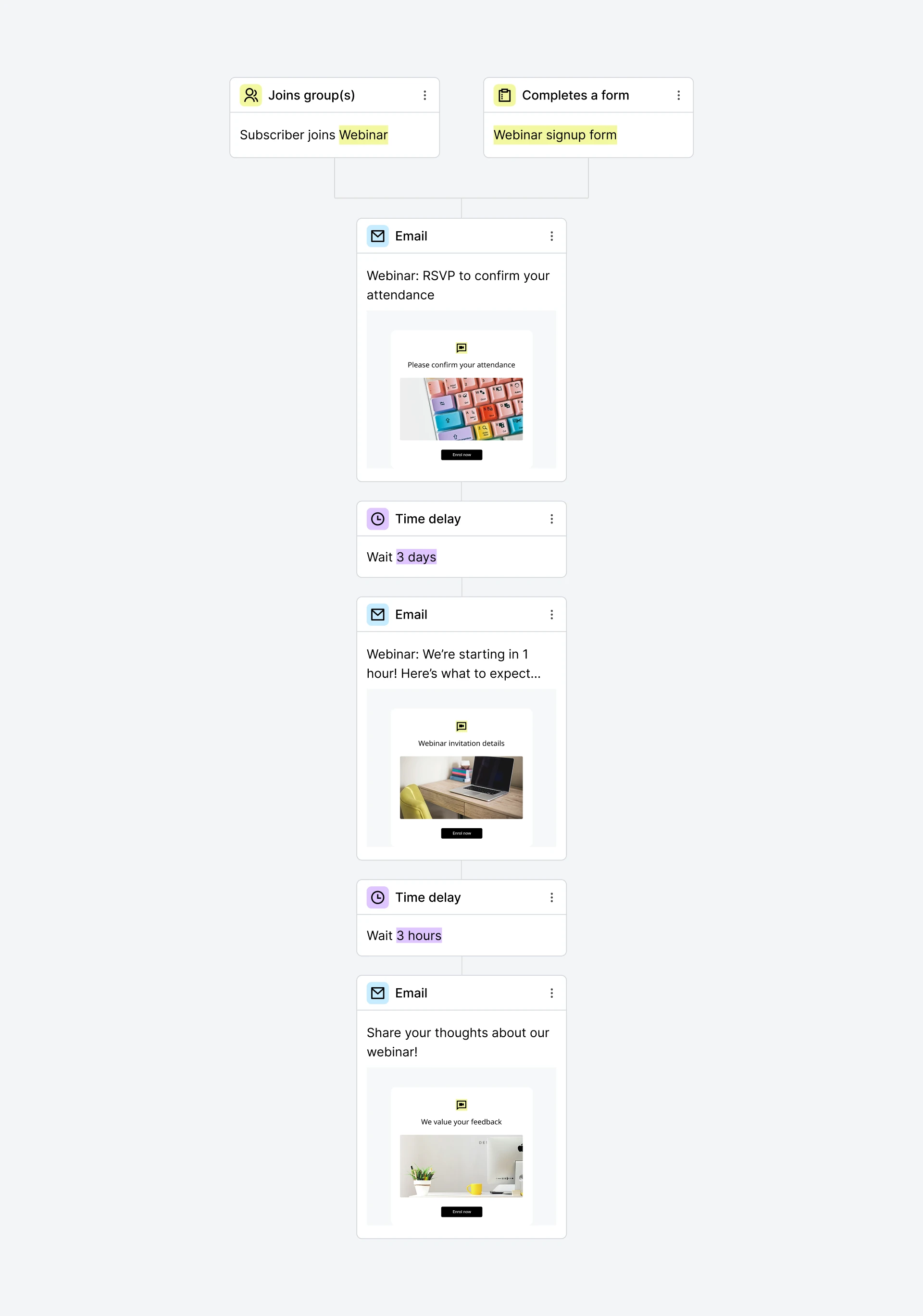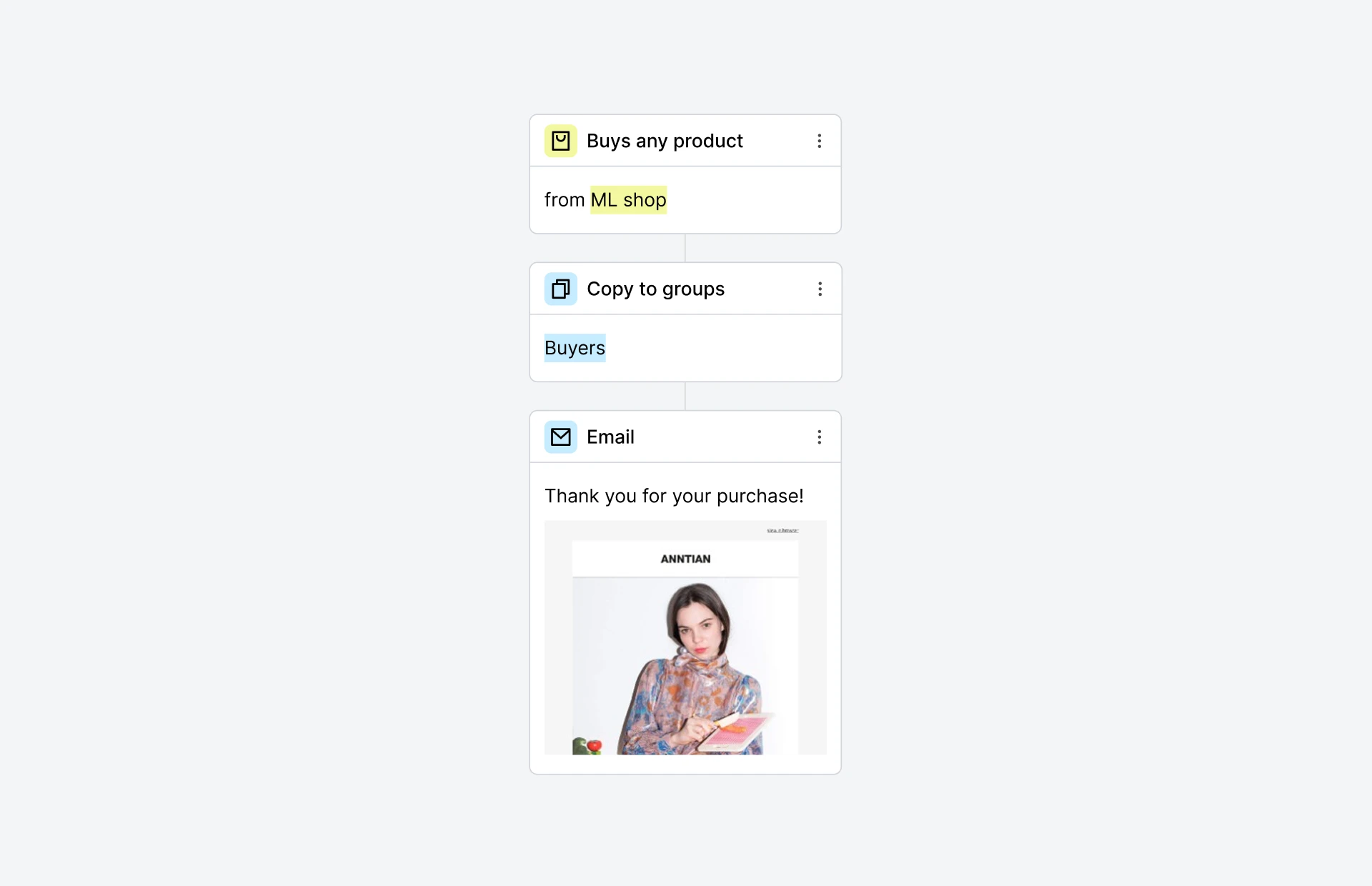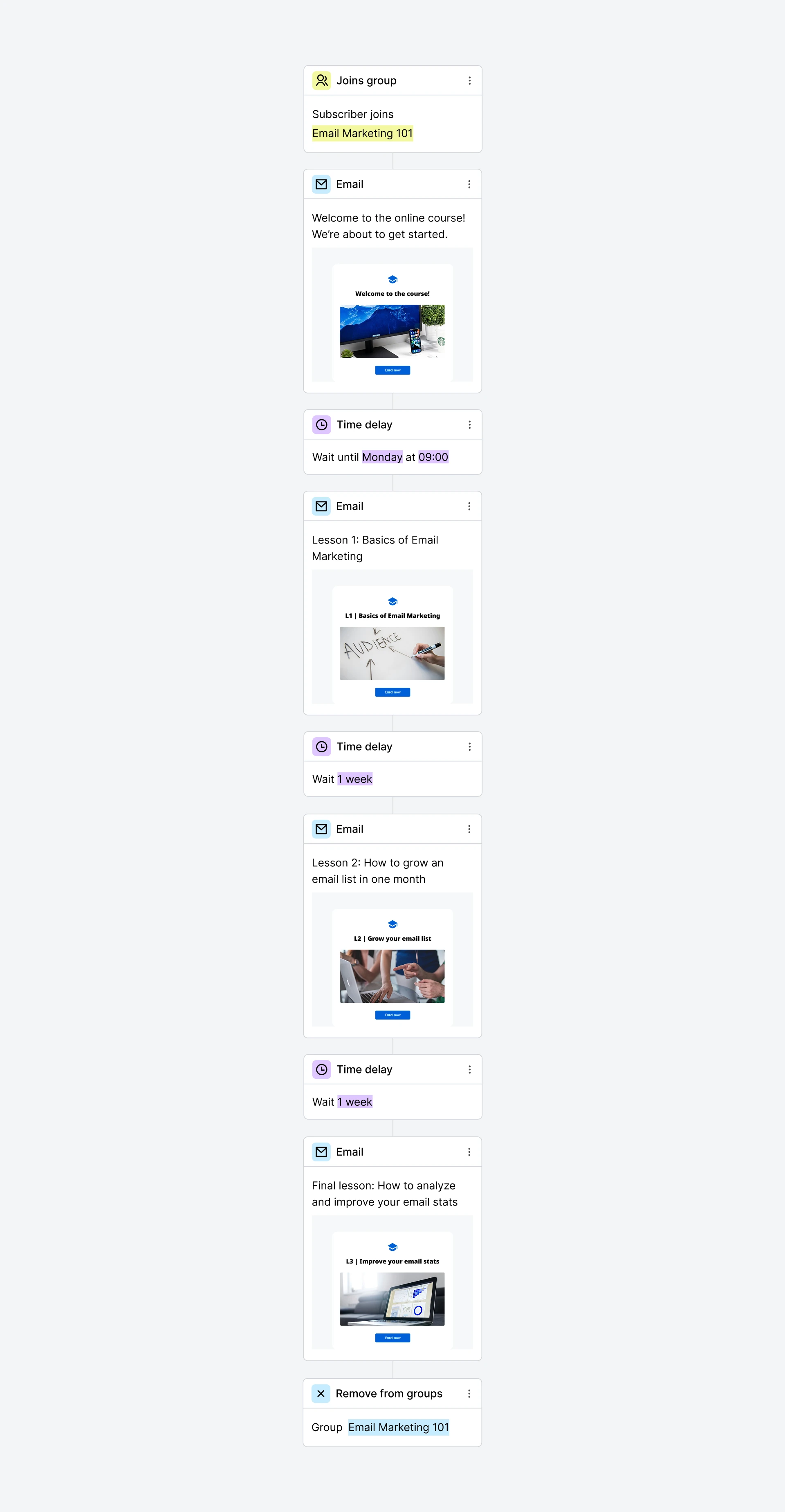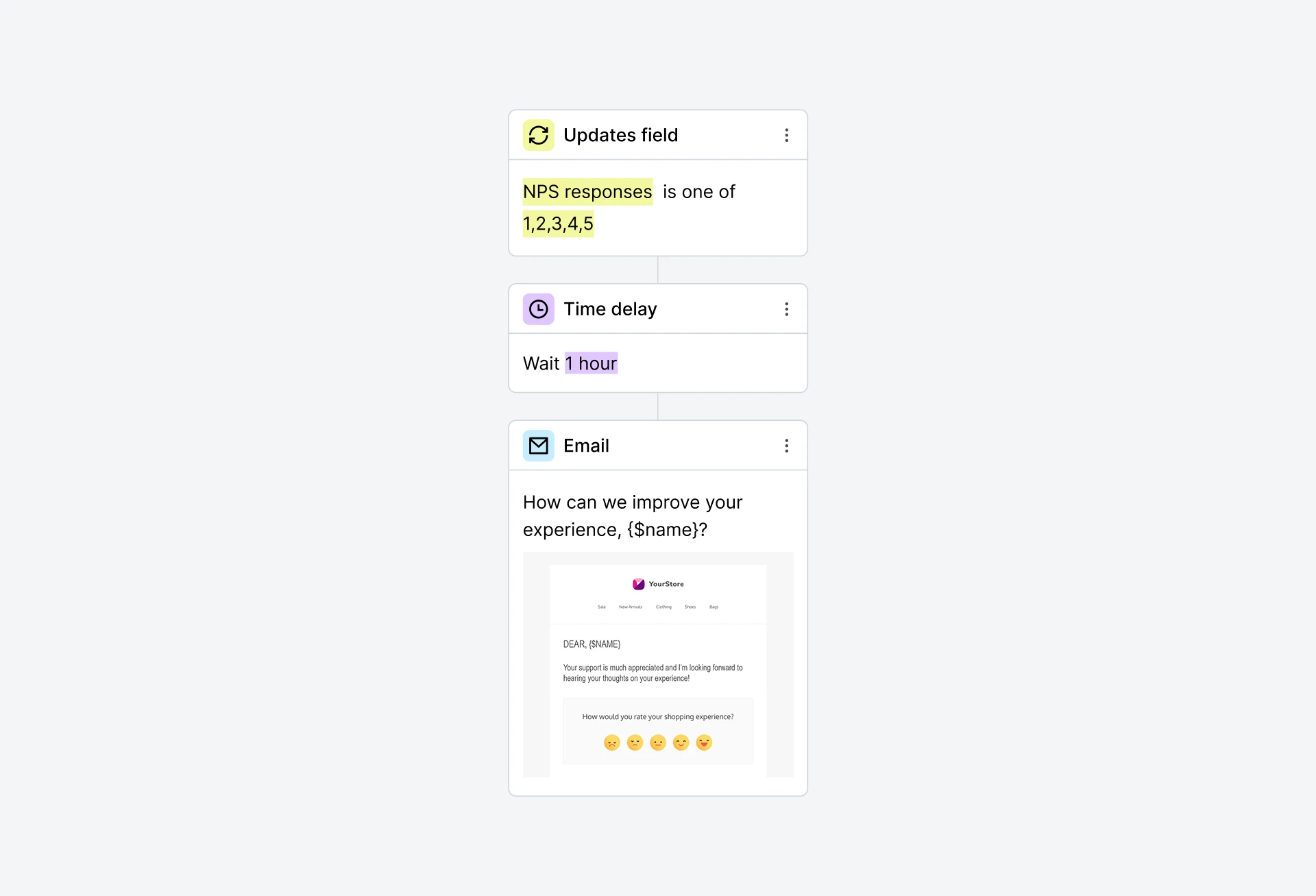Top templates and tips to create a winning email sequence
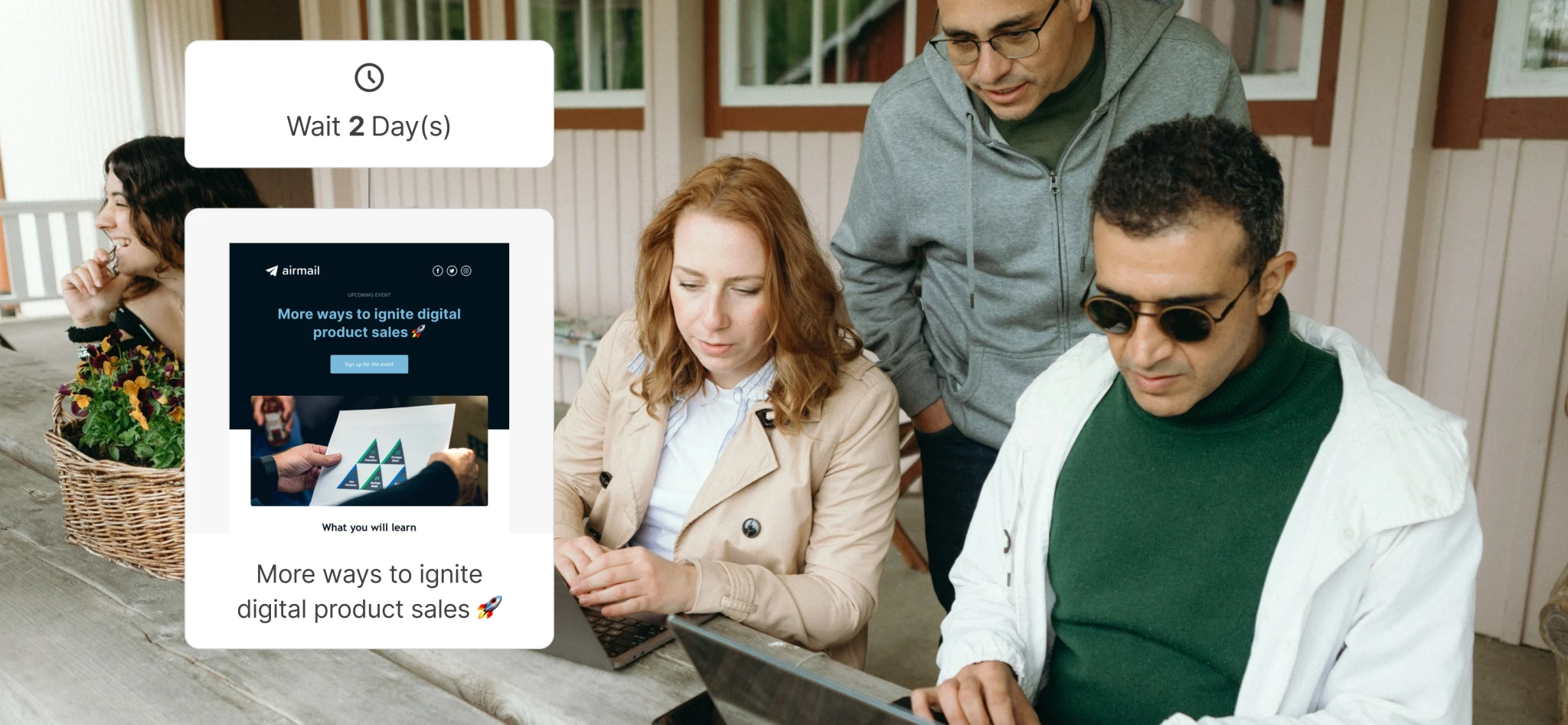 Kata, Andres, and Amer, marketing team.
Kata, Andres, and Amer, marketing team.
Email sequences are as close as you’ll get to a secret spell for growing your business with email.
Why? Because workflows ensure you send the exact content your subscribers need at the precise time they need it, without you lifting a finger.
Use email sequences to nurture leads into buyers, increase customer value through upsells, learn about your audience, save abandoned checkouts, re-engage subscribers, and more.
Read on to discover more about email sequences, including what they are, examples, templates, and how to build them with MailerLite.
What is an email sequence?
An email sequence, also known as a workflow or automation, is a series of automated emails that go out over time to help with a particular objective, like onboarding or lead nurturing.
These emails are triggered automatically by an action, such as a form completion or product purchase, that suggests the recipient is at a stage in the customer journey where it would be useful to receive the messages.
This combination of timed triggers and targeted content means email sequences are extremely effective. Our data shows that automated emails have open rates that are 15% higher and click rates that are 152% higher than regular campaigns.

Email sequences can be static, meaning everyone who sets off the trigger receives the same emails. But they can also be dynamic and change based on how people interact with the previous emails in the workflow.
For example, an e-commerce store could send different messages to people who click on a link to baby clothing and people who click on a link to children's clothing, so each customer group receives content relevant to their needs.
An email sequence is a series of emails automatically triggered by a customer action. They only go out to the person who triggers the email. They are typically built to streamline particular points in the customer journey and provide targeted information when it is needed most.
An newsletter is a single email that you send to your entire list or list segment at the same time. These emails contain more general and often time-sensitive information.
13 email sequence templates you can use
You can use email sequences to automate any part of the customer journey—just think about places with friction and whether email would help streamline the process. If you’re in need of inspiration, this section will highlight the most common types of sequences and provide templates you can use to build your own workflows.
Build your first email sequence today
MailerLite’s powerful yet easy-to-use email sequence builder has all you need to start automating your customer journey. Try it today with a free trial!
1. Welcome sequence
A welcome sequence is a series of emails that go out when someone first joins your list. They are used to start the relationship with the subscriber, deepen the connection, and introduce the recipient to your brand and products.
These emails usually explain more about your brand, highlight important educational resources, and link to your social channels or community so you can build a deeper relationship. If you promised the subscriber something in return for them joining your list, such as a discount coupon, you should also include this in your email.
Welcome email sequence template:
Welcome email: Provide more information about your brand or business. Include coupons or lead magnets if promised on the sign-up form.
Discovery email: Find out about the recipient's interests with surveys or your preference center. Use this information to segment your list.
Next steps email: Outline steps customers can take to engage with your business. Send links to your community, social channels, webinar, or popular resources.
Coupon or offer email: Send an offer or coupon to encourage people to buy while interest is still high.
Learn more about how to set up your welcome sequence here, or use our prebuilt welcome email automation template to get started quickly.
2. Advanced welcome sequence template
Once you have your welcome sequence up and running, consider going deeper into MailerLite’s features to create an advanced welcome automation that adapts to each user.
This is especially useful if your business attracts multiple customer types. For example, a clothing store’s welcome sequence could adapt depending on whether the person shows an interest in men’s or women’s clothing.
But it’s also a great way for any business to create more impactful sequences that better welcome subscribers and generate sales.
Advanced welcome email sequence template
Our advanced welcome email template has several pro features that you can customize to create your sequence:
Multiple triggers: Choose which customer actions cause the automation to start.
Link click conditions: Send different content depending on whether the recipient clicked a link or not.
Action blocks: Update fields in the subscriber’s profile when they take certain actions.
Try out our prebuilt advanced welcome sequence and experiment with the features to see what it can do.
3. Onboarding sequence
Onboarding email sequences help new signups learn how to use your product and begin seeing its value. These sequences may encourage people to complete setup, create a profile, take a lesson, or connect third-party accounts or tools.
Onboarding sequences are especially useful for subscription products like SaaS, communities or courses. A good onboarding sequence helps subscribers see the product’s value straight away, which can lead to them staying a customer for longer.
Onboarding sequence template:
Confirmation email: Confirm that the user has successfully signed up and provide relevant product information.
First steps email: Explain the first steps the user should take to get started with your product. Provide a link and clear instructions.
Feature email: Use segmentation and dynamic content to highlight features that will help the user with their specific needs.
Reminder emails: If the user is on a free trial, remind them before it ends that they will need to sign up for a paid plan to continue.
Here’s an onboarding sequence automation workflow created with MailerLite:
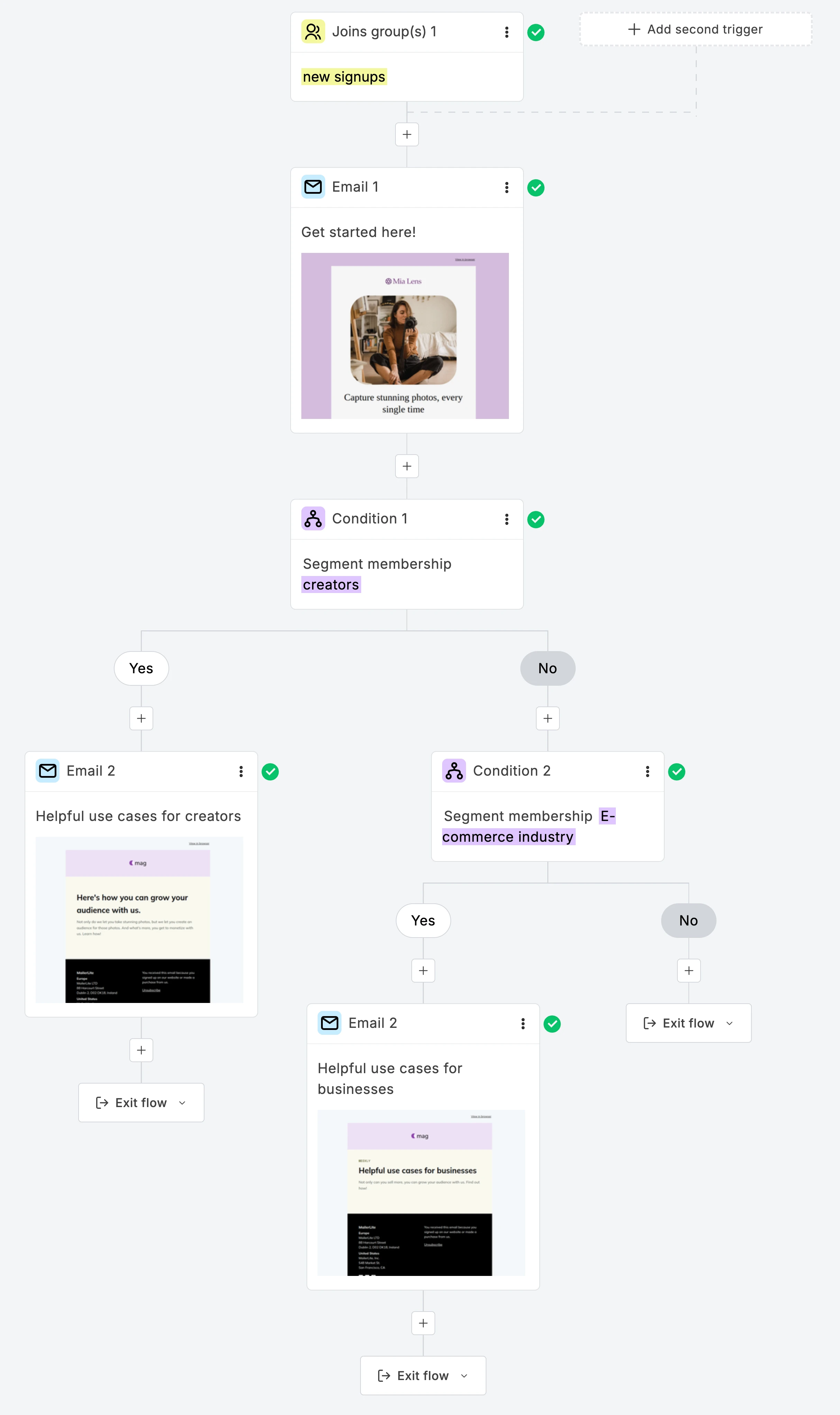
4. Abandoned cart email sequence
Your user almost made a purchase. But then they abandoned the shopping cart before completing the purchase. In this case, an abandoned cart recovery email series can be an easy way to bring them back to the checkout.
These emails are an effective way to increase conversions because they remind the subscriber about your product and link back to the purchase page. As these sequences have a very specific goal, they are typically just 1 or 2 emails long.
Abandoned cart email template:
Abandoned cart email: Send an email with a dynamic product box that shows the product the customer was looking at and links to the checkout page.
Reminder email: Send a reminder email the following day if the subscriber didn’t interact with the initial email.
E-commerce stores can easily set up an abandoned cart email with our pre-built template. Just select the template below and then customize it to your needs. Or click here to find out more about our e-commerce integrations.
5. Re-engagement email sequence
Re-engagement sequences activate subscribers who haven’t opened or clicked on your emails in a while. This is important because having a large percentage of inactive subscribers on your list can impact email deliverability, so it’s best to remove them. A re-engagement email is your chance to bring them back before you take this final step.
To create a re-engagement sequence, you’ll first need to use our subscriber segmentation feature to create a segment for people who no longer engage with your emails. Then, create an automation that is triggered when someone joins this segment. Finally, send an eye-catching offer or piece of content that will stand out and convince them to open your messages.
Re-engagement sequence template:
Opening email: Send an eye-catching offer that the recipient can’t help but open.
Last chance: Resend the offer to anyone who didn’t interact with the first email.
Click to learn more about re-engagement campaigns and set one up in a flash with our pre-built template.
6. Nurture sequence
Nurture sequences build the relationship with subscribers further, which brings them closer to the point where they are ready to buy. Use them to show how your product can help and provide useful resources around the problem.
Send these sequences to people who you know are interested in your product because they’ve taken action like signing up for a lead magnet, product demonstration, webinar or trial.
Nurture sequence template:
Confirmation email: Confirm the action the lead took to join your list. This could be providing a link to a lead magnet, webinar or free course.
Educational email: Share information that educates the lead about how your product or service can help them.
Social proof: Send reviews, testimonials or social posts that show people talking about how great your business is.
Next steps: Invite prospects to take the next step with your business, whether that’s signing up for a free trial, taking advantage of an offer, setting up a meeting, or joining a webinar.
Read this article to learn how to set up a nurture email sequence and discover inspiration for the types of emails to include.
7. Renewal sequence
A renewal sequence is a set of emails sent by a subscription business to people who are coming to the end of their subscription period. The idea is to reaffirm the value of your product, remind the customer about the upcoming payment and ultimately stop them from churning.
Renewal sequence template
Reminder email: Mention that the contract is ending soon and provide information about how to resubscribe.
Value reinforcement: Highlight all the ways the product helps people like them. Use segmentation or personalization to ensure the content speaks to their needs.
Updates and new features: Send an email that lists all the recently released and upcoming features that could convince them to stick around.
Offer or last chance: Send a last chance email in the days before the contract ends. Consider adding an offer to increase retention and encourage people who have yet to sign up to do so.
Use our membership renewal email workflow to quickly set up a renewal campaign that goes out based on a date in the memberships field of a customer’s profile.
8. Conversion sequence
Conversion sequences are solely focused on getting people to convert. This could mean buying your product, signing up for a trial, setting up a sales meeting, or any other bottom-of-funnel action. These emails typically include persuasive content such as calls to action (CTA), countdowns and offers.
Conversion template:
Opening email: The first email should relate to the action the subscriber took that makes you think they are ready to convert. For example, thanking them for signing up for a trial or taking a product demonstration.
Benefits email: Make the benefits of your product clear. Use segmentation to create personalized emails targeted to specific customer types.
Social proof: Send reviews, testimonials or social posts that show people talking about how great your product is.
Offer: Send an offer that subscribers can't help but take up. Use a countdown timer or limited-time discount to encourage the user to commit.
Many email sequences will contain parts of other types of sequence. For example, a nurture or welcome sequence may also contain conversion-focused emails. It all depends on how you set up your email funnel.
9. Event sequence
Get people ready for your next event with an event sequence email workflow. Generate interest and keep people excited by sending event-related content. Use the sequence pre-signup to grow your event audience, and post-signup to keep interest high and provide all the information people need to show up.
Event sequence email template:
Confirmation: Start by sending an email to signups with event details and a confirmation that their signup was successful.
Event details: This could be a single email or a series of emails highlighting speakers, sessions or any other relevant event information.
Reminder: Send a reminder email a couple of days before the event. Include anything that will help people prepare.
Post-event survey: Thank people for attending the event and ask them to complete an email survey you can use to make the next one even better.
Use our webinar invite template to send an email sequence to anyone who signs up for your webinar. You can easily edit the template to be relevant to other events and add or remove emails.
10. Follow-up email sequence
Follow-up sequence emails go out after the user completes an action, for example, making a purchase or signing up for a consultation. Use them to confirm the action, request feedback, ask for reviews, or recommend related products.
Follow-up email template:
Confirmation: Send an email confirming that the action the user took was successful.
Survey: Ask recipients to take a survey to gauge their satisfaction with the action they took.
Upsell email: Send an upsell or cross-sell email with related products that the customer may be interested in buying.
E-commerce stores can quickly set up a follow-up email sequence with our post-purchase template. It goes out whenever someone buys a product, and you can easily add more emails to the sequence.
11. Email course sequence
Email courses are a great way to provide value to your customers or potential buyers.
Create a free course around your area of expertise that acts as a lead magnet or nurture sequence. Teach something valuable and then offer your services at the end, in case the customer would prefer to buy a done-for-you service.
Or, use our digital products feature to create a premium email course that people need to buy to access. Trigger the course when they purchase and deliver it in the days or weeks after the purchase.
Online course email template
Our online course template starts when someone joins the group you created for the course. Link this to a signup form for a free course or a digital product for a paid one.
The template also uses the Delay step to wait until the first Monday after someone joins to send the first lesson. This can be useful if you want all your learners to take the course on the same day.
It then has 3 lessons. These are just placeholders; you can add as many lessons as you like. Duplicate the previous step or use an email template to create lessons quickly.
The template ends with an action step that removes the subscriber from the course group.
12. Birthday email sequence
Create an automated email sequence that congratulates your subscribers on their birthday and delivers a gift, coupon or discount.
For this to work, you’ll first need to collect the subscriber's email address. Add a field to your signup form or send a dedicated email to your list with a survey to collect this information.
You’re sure to get plenty of signups if you mention that you’ll send something special on their big day.
Birthday email sequence template
Our birthday email sequence uses the anniversary of a date sequence to trigger the automation in the days before the subscriber’s birthday.
It then contains 2 emails, use one to mention the birthday discount and then one to congratulate them on the big day (and remind them about the discount).
13. Survey email sequence
Your email subscribers are a great source of insight you can use to improve your product or service.
Put this data collection on autopilot with a survey email sequence. Use a MailerLite survey to allow people to respond without leaving their inbox, or link to an external platform.
Survey email sequence template
Trigger this sequence after someone interacts with your brand. This could be after they make a purchase, attend an event, start (or cancel) a subscription, or speak with your support.
Then send the following survey emails:
Send an initial email with a link to the survey.
Add a condition that sends a reminder email to people who didn’t open the first email.
Send follow-up emails related to the survey. For example, if someone gave positive feedback, you could thank them and ask for a review.
Inspiring real-life email sequence examples
Here are 2 examples of email sequences that show how brands are using email sequences in real life.
Nurture sequence example: MailerLite
You won’t be surprised to hear that we have plenty of email sequences set up at MailerLite. One of the main ways we use them is to deliver our many lead magnets to people who request them. These aim to deliver the lead magnet and nurture the relationship with the subscriber.
Here’s a look at the automation we send out when someone downloads our digital product ideas lead magnet.
28 digital product promotion ideas: The first email contains a link to the digital product ideas resource that people signed up to receive.
More ways to ignite digital product sales: We then send links to guides that explain digital product sales strategies.
Essential digital product marketing tools: The final email explains how people can use MailerLite to start selling their digital products.

Onboarding sequence example: Zapier
Zapier offers a 14-day free trial of its automation software, and uses an onboarding sequence to help people get set up and increase the likelihood that they will turn into paying customers.
Here’s a look at each email the company sends:
Welcome to Zapier!: The first email explains the basics of the tool, provides links to help resources, and includes a call to action asking readers to create their first automation.
Top ways to automate your work: This email includes links to the most popular tools people use the platform with.
Not sure what to automate? This is a targeted email that shows automation relevant to the subscriber’s job role.
Trying to stay ahead of marketing trends? This email links to a report that highlights how marketers feel about automation.
Get more ROI out of automation: This email highlights 5 ways you can use automation for lead tracking.
Your trial ends in 3 days: This reminds the subscriber that the trial ends soon, highlights the paid features they’ll lose access to, and includes a CTA asking recipients to upgrade their plan.
Get 3 months of our Starter plan for $10: Zapier sends a special offer to anyone who has yet to sign up.
How was your free trial?: The final email contains a survey asking for feedback about the free trial.
Once the user finishes the sequence, they should have all the information they need to successfully use the tool.
7 steps to create an effective email sequence
Creating an effective email sequence is simple thanks to email marketing software like MailerLite. Here is a step-by-step guide you can use to get set up.
1. Decide your goals
Your email sequence should have a specific aim, so make sure you know exactly why you are creating the email sequence before you move on to the next step.
Use the examples in this article as inspiration, or head to our email workflow templates page to discover more about the kinds of sequences you can set up.
2. Set your trigger
An email sequence starts when the subscriber takes an action that triggers it. With this in mind, you need to decide what will trigger your workflow.
Consider starting a sequence when someone:
Subscribes to your list
Fills out a form
Downloads a lead magnet
Sign-ups for a free trial
Buys a product
Clicks on a link in a previous email
Reaches a particular date
The key is to look for actions where it will be beneficial for the subscriber to receive targeted information. Check out this guide to learn about the 10 email automation triggers you can use to start your next sequence in MailerLite.
3. Plan your emails
Now you need to decide which emails to include in your sequence. The number of emails you include will depend on the type of email sequence you want to set up and your goal.
For example, onboarding email sequences are typically quite long as they have to include all the information people need to start using your product. But an abandoned cart sequence will just have 1 or 2 emails that go out soon after the customer leaves checkout.
4. Consider your email timing
In most situations, your first email should go out as soon as it is triggered. You can then use our delay feature to send follow-up emails minutes, hours, or even days after the initial message.
When thinking about the timing of these emails, consider when it will be useful for the customer to receive the email.
For example, an event email sequence will typically spread the automated emails out over the course of the event buildup. But the emails in an e-commerce welcome sequence should go out soon after sign-up, as this is when interest is likely to be highest.
5. Add conditions
The most impactful email sequences change depending on how people interact with them to ensure signups get the most relevant messages.
You could send:
Reminders to people who didn’t open an email
Product recommendations to people whose activity suggests they have a particular interest
Special offers to customers who are yet to buy
Confirmation details to people who complete a form
In MailerLite, you can split your workflow depending on factors including whether the person opened an email, clicked on a particular link, clicked on any link, is a member of a group, or has a profile field that matches a specific value.
See a simple example of how this works for a webinar promotion sequence below.
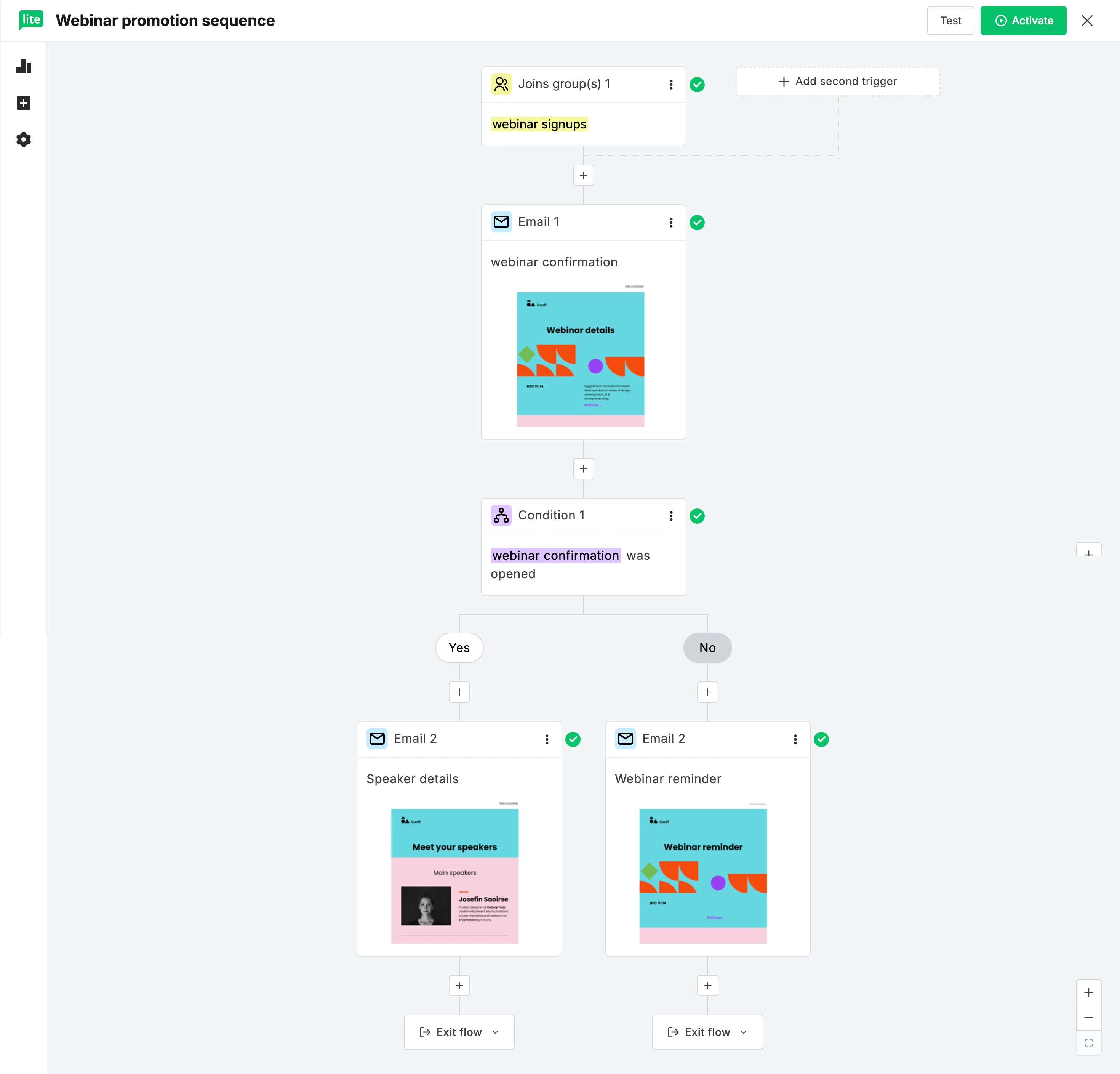
6. Create your emails
Now is the time to create and write your emails. Our new drag & drop builder contains everything you need to easily design beautiful emails.
Here are some tips to help you get started:
Use consistent design (colors, fonts, imagery) so people instantly recognize your brand
Use product boxes, buttons, and CTAs to encourage people to take action
Use our AI assistant to help write email copy, calls to action, and titles
Start with one of our professionally-designed email templates to get a beautiful email that fits your needs
Use dynamic content and personalization to target your emails at a specific audience
Spend extra time on your subject line, as this is essential to getting people to open your emails
Use MailerLite’s email marketing MCP server (that connects your MailerLite account with AI tools like ChatGPT) to quickly create an email draft based on your audience, past campaigns, and performance, using a simple prompt (Psst…that’s not all, our MCP server can do way more than that. Check the use cases here.)
For more tips, check out this article on how to design beautiful emails, and this one about how to write email content people care about.
7. Analyze the results of your campaign
You’ll begin to collect data about how people interact with your sequences as soon as you set them live. Use this to see what’s working and take steps to optimize your campaign.
Here are some of the main email marketing metrics to look for. You can see all these metrics in the Overview section of each automation in your MailerLite dashboard:
Open rate: Look at the open rate for each email in the sequence. If one is particularly low, consider changing the subject line or the focus of the message. In most workflows, the initial email will have the highest open rate, so it’s not necessarily a problem if subsequent ones drop off
Click rate: This shows the percentage of people who click on each email. Consider experimenting with your offer and CTA to increase this
Link activity: This report highlights which links people are clicking on. Use this to confirm that people are clicking on the content you want them to view. You’ll also see which offers and wording people find most attractive
Orders and revenue: E-commerce stores can see the number of orders and total revenue generated by each email in their sequence. Use this to identify the emails and content that most effectively generate sales
Also, consider using workflow A/B testing to send 2 different versions of an email in your workflow to find out which one works best.
For example, you could send 2 post-purchase recommended product emails with different offers and see which results in more sales, or 2 re-engagement emails with different subject lines to see which results in more opens. You can then roll out the winners to all future signups.
It’s time: Create your email sequence with MailerLite
Now you know all about email sequences, it’s time to create your own with MailerLite. Head to your dashboard to get started or click here to create an account: even our free plan comes with everything you need to create powerful marketing automation.
Head to the Automation section of your dashboard.
Click New Automation.
Choose one of our templates for easy setup, or click Start from scratch.
Choose the event that you want to trigger the automation.
Add an email, fill out the details, and add the content.
Add extra emails to the sequence by adding the Delay block, configuring a time period, and then adding your next email.
Experiment with Conditions, Actions and A/B test to create more powerful sequences that effectively target the new subscribers’ needs.
Save your automation and switch the toggle to set it live
That’s just a basic overview of how the MailerLite automation builder works. For a more complete guide, check out our knowledge base article on how to create automation with MailerLite.
You can also drop a comment below if you have any further questions!
